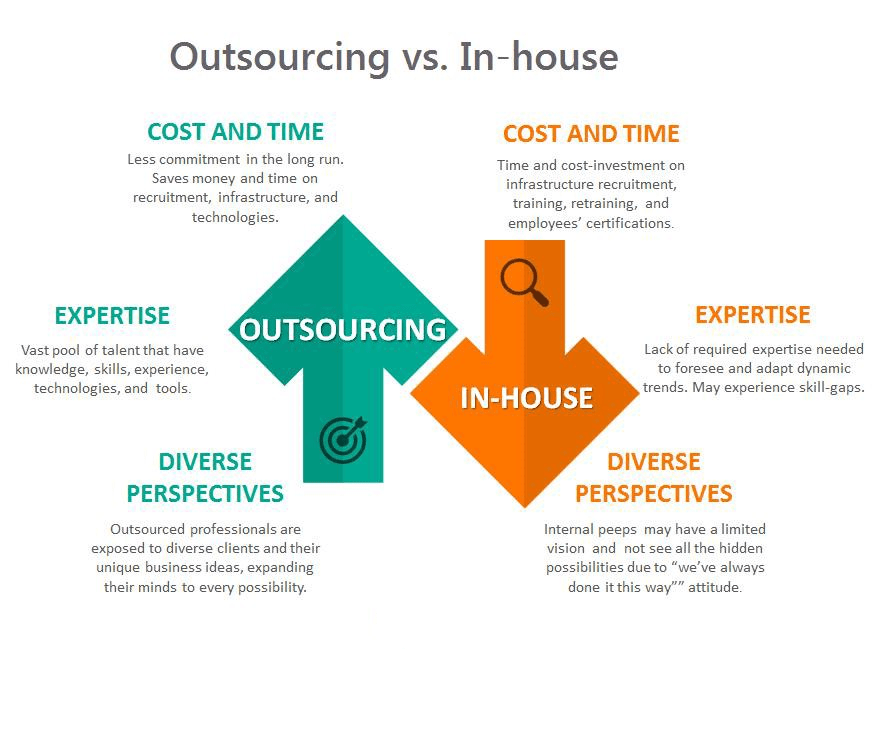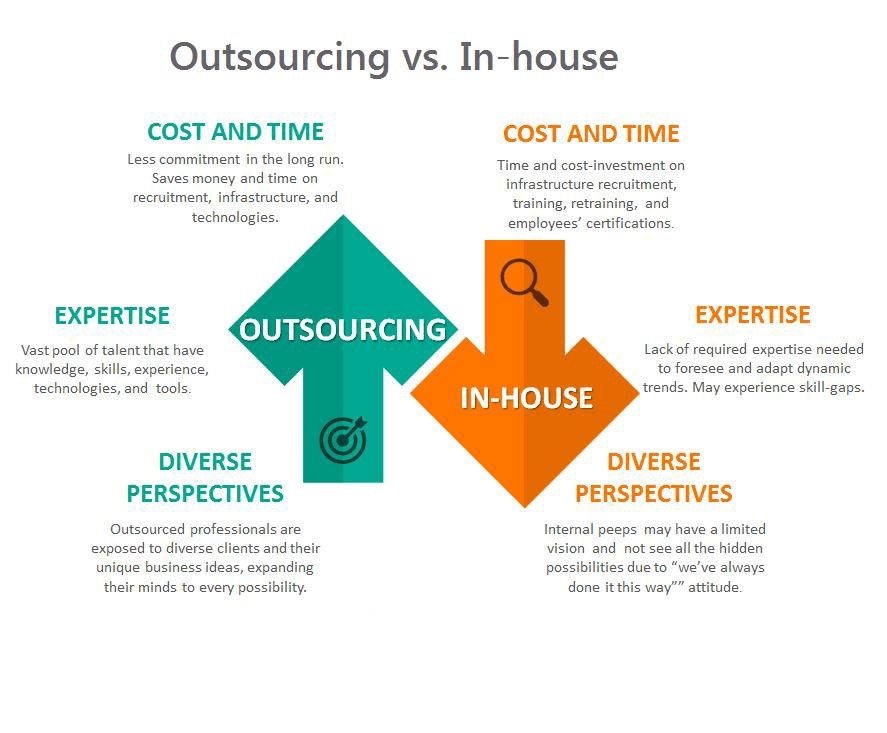Explore the pros and cons of in-house vs. outsource IT teams in 2025. Discover real-world examples, costs, and tips to choose the best IT model for your business.

Discover how
empowers businesses through integrity, innovation, and collaboration.
In 2025, companies face a pivotal question when scaling their IT infrastructure:
Should you build an in-house team or outsource IT operations?
The global IT services market is set to reach $1.37 trillion this year (Statista), highlighting the critical role technology plays in every industry.
Your IT sourcing decision can influence operational efficiency, innovation speed, security posture, and long-term growth.
In this guide, we break down the advantages and disadvantages of in-house versus outsourced IT teams — packed with data, real-world case studies, and actionable insights to help you make the right call.
In-House IT Teams: Pros and Cons
Pros
1. Full Control and Immediate Access
With in-house teams, communication is direct and immediate. You control project execution, timelines, and quality without external dependencies.
2. Cultural Fit and Alignment
Internal employees fully absorb your company’s values, mission, and work culture.
According to SHRM, teams aligned with company culture perform 12% better on average.
3. Enhanced Security
Sensitive data remains within company firewalls, reducing the risk of external breaches or third-party mishandling.
Cons
1. Higher Cost
In-house staffing is expensive.
Example: The average U.S. IT professional earns $110,000/year (BLS), not including benefits, training, and retention efforts.
2. Limited Scalability
Hiring and onboarding new team members take time. During rapid growth or emergencies, internal teams can quickly become stretched thin.
3. Skills Gap
63% of IT leaders (Gartner) report difficulty finding experts in emerging fields like AI, DevOps, and cybersecurity.
Outsource IT Teams: Pros and Cons
Pros
1. Cost Efficiency
Outsourcing can slash IT costs by 30% to 60%, especially when leveraging global talent pools in countries like India, Vietnam, and the Philippines.
2. On-Demand Scalability
Scale teams up or down as projects evolve — without long-term hiring commitments.
3. Access to Specialized Expertise
Outsourcing firms often invest heavily in upskilling their teams.
You’ll gain access to top-tier experts in:
- Cloud computing
- Cybersecurity
- AI/ML
- Blockchain
Cons
1. Communication Barriers
Time zone gaps, language differences, and cultural nuances can sometimes cause delays or misalignment.
2. Less Control
Quality assurance, project timelines, and security measures are partly outside your direct oversight.
3. Data Security Risks
Sharing access to sensitive systems with third parties introduces compliance and confidentiality risks.
2025 Cost Comparison: In-House vs. Outsource IT Teams
| Cost Factor | In-House (U.S.) | Outsourced (India/Philippines) |
|---|---|---|
| Developer Salary | ~$110,000/year | ~$25,000/year |
| Infrastructure | ~$10,000/year | Included |
| Recruitment & HR | ~$8,000/year | Minimal |
| Total Cost | ~$128,000/year | ~$25,000–$30,000/year |
When to Choose In-House IT Teams over Outsource Teams
- You require tight collaboration on a long-term product.
- Data security and compliance are top priorities.
- You have the budget to invest in building a local talent pipeline.
When to Choose Outsource IT Teams
- You’re launching a new product and need to scale quickly.
- You have budget constraints.
- You need specialized skills that are hard to find locally.
Hybrid Approach: The Best of Both Worlds?
In 2025, more companies are choosing hybrid IT strategies, keeping core operations in-house while outsourcing specialized projects.
According to Deloitte, 70% of enterprises now blend in-house and outsourced IT models — balancing control, cost, and flexibility.
Example Hybrid Strategy:
- In-house team handles strategic IT planning and core infrastructure.
- Outsourced partners manage mobile app development and cybersecurity audits.
Final Thoughts
Choosing between an in-house or outsourced IT team in 2025 is a strategic decision that hinges on your company’s goals, budget, risk appetite, and growth plans.
Use this guide as a framework to assess your options carefully — and remember, a hybrid model might offer the perfect middle ground.
Read more posts:- CQRS and Event Sourcing in .NET 8: Best Practices for Scalable Applications.



Pingback: Growth Strategies->Optimizing B2B Paid Media Budget - BGSs